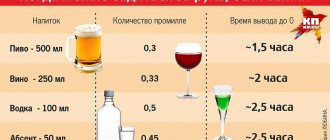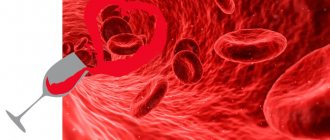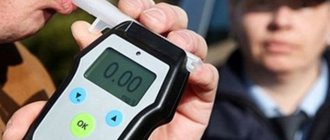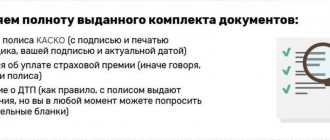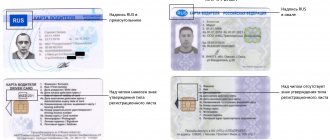Permille: what is it?
Permille is one thousandth of the content of a substance in something.
Therefore, the answer to the question, 1 ppm is how much alcohol, is quite easy to obtain: 1 liter of blood contains 1 g of ethanol.
When drinking drinks of different strengths, you should calculate this indicator, since it will vary. For example, 1 ppm - how much vodka? It is important to take into account the person’s weight and gender. The percentage of fluid in a man's body is 70, in women - 60. The average weight of a man is about 70-75 kg. So, after 100 g of vodka, that is, 40 g of alcohol, the alcohol level will be 0.55 ppm.
How is ppm determined?
Calculations in thousandths are practically no different from mathematical operations in percentages. Permille is usually denoted by the sign ‰. This icon is very reminiscent of the well-known percentage “%”, however, there is a significant difference between these designations. In the process of determining the ethanol dose, the following translation is used :
- 10‰ = 1% = 10/1000 = 0,01;
- 1500‰ = 150% = 1500/1000 = 1,50;
- 250‰ = 25% = 250/1000 = 0,25;
- 450‰ = 45% = 450/1000 = 0,45;
- 0,20‰ = 0,02% = 0,2/1000 = 0,0002.
As this example shows, converting ppm to percentage and back is not very important. Here you need to understand only the basic relationships .
Knowing the ratios allows you to easily obtain the data required to calculate the dosage of alcoholic beverages consumed, the level of alcohol in the blood and the time required for the breakdown of metabolites.
To perform more calculations, you need to know several important parameters :
- age;
- floor;
- weight;
- current health status;
- psychological condition;
- the type of alcoholic beverage consumed.
Permille and car driver
If the alcohol content exceeds 0.3-0.6‰, the driver is considered to be drunk. An error in the dose is needed for people who do not drink, but take medications, have specific gastrointestinal diseases, and those who consume some of the products described above.
If the driver’s drunken state is confirmed, sanctions are immediately applied to him: if the violation is the first, then it is a fine of 30,000 rubles and deprivation of rights for a period of 1.5-2 years; if the violation is repeated, more stringent measures follow.
Ratio m/g and ppm
According to current legislation, the maximum permissible dose of alcohol-containing drinks in a driver’s blood is 0.16 mg/l . This means that the maximum permitted ppm in the air that a motorist exhales is 0.34‰ . If the breathalyzer shows a higher result, the driver will be administratively liable for drunk driving.
To understand the correspondence and difference between milligrams and ppm, a special table for converting ppm to mg l is used. This table provides several states:
- The norm is up to 0.3 ‰ or up to 0.135 mg/l in the air flow.
- “Drinking” - up to 0.9 ‰ or up to 0.405 mg/l in the air flow.
- The primary degree of intoxication is up to 1.9 ‰ or up to 0.855 mg/l in the air flow.
- The second degree of intoxication is up to 2.9 ‰ or up to 1.305 mg/l in the air flow.
- Severe stage of intoxication - up to 3.9 ‰ or up to 1.755 mg/l in the air flow.
- Alcoholic coma – from 4 ‰ and from 1.8 mg/l in the air flow.
The legislative framework
There are a number of legal acts that traffic police officers and drivers are guided by:
- Federal Law No. 528 – changes in legislative acts on increasing driver responsibility.
- Federal Law No. 63 is stated in the Criminal Code of the Russian Federation.
- Decree of the Government of the Russian Federation No. 1090, establishing traffic rules.
- Federal Law No. 195 is spelled out in the Code of Administrative Offences.
Violation of current legislative norms leads to administrative or criminal liability in the form of fines, deprivation of a driver's license, and imprisonment. In 2021, bills are being considered that could increase the punishment.
Refusal to undergo a medical examination is equivalent to an admission of guilt and, therefore, entails punishment.
table 2
| Type of drink, alcohol content in% | Quantity (ml) | Time during which alcohol vapor can be detected in exhaled air (hour) |
| Vodka (40) | 50 | 1,0-1,5 |
| Vodka (40) | 100 | 3,0-3,5 |
| Vodka (40) | 200 | 6,5-7,0 |
| Vodka (40) | 250 | 8,0-9,0 |
| Vodka (40) | 500 | 15,0-18,0 |
| Cognac (40-45) | 100 | 3,5-4,0 |
| Champagne | 100 | 1,0 |
| A mixture of cognac and champagne | 100-150 | 4,0-4,5 |
| Port wine | 200 | 3,0-3,5 |
| Port wine | 300 | 3,5-4,0 |
| Port wine | 400 | 4,5-5,0 |
| Beer (2.8) | 500 | Not determined |
| Beer (3.4) | 500 | Not determined |
| Beer (6) | 500 | 20-45 minutes |
We must not forget about the errors of diagnostic instruments that measure alcohol content, amounting to 0.1-0.16 ppm. This means that it is better to add at least one more hour to the above figures.
Acceptable ppm standards when driving
In most countries in America and Europe, it is permissible for the blood of a person driving a vehicle to contain a certain amount of ppm of alcohol. The most common limit is 0.5 ppm, but countries such as the UK, Italy, Luxembourg and Ireland have raised this limit to 0.8 ppm. And the highest permitted level is up to 1 ppm, which is allowed in some US states.
The legislation of some countries generally prohibits drinking alcohol before driving a car, and a drunk person is not allowed into the car. These include Romania, Bosnia-Herzegovina, Hungary, Czech Republic, Liechtenstein, Croatia, Slovenia, Albania, Azerbaijan, Georgia, Moldova. In these states, it is believed that the driver must be absolutely sober, his body must contain 0 ppm, and even for drinking a bottle of beer before the trip he will have to answer quite strictly.
In Ukraine there was such a rule, but later the norm was raised to 0.2 ppm. As a result, traffic police officers were faced with a problem when breathalyzers detected alcohol within such limits in those suffering from various diseases. The person had to document the presence of the disease, but if he could not do this, but looked sober, the driver was accused of being hungover.
The history of the permitted degree of intoxication of drivers in Russia is distinguished by quite different approaches, often negating each other.
So, in 2008, a law was adopted on the permitted 0.3 ppm. In principle, this norm may well be considered safe. But our drivers did not calculate the numbers, drank more than they should and created accidents caused by intoxication. In addition, this law was adopted taking into account the errors of breathalyzers and the usual physiological characteristics of the body, which in one way or another affect the indicators of the device.
However, already in 2010, this decision was canceled and the “prohibition law” came into force, completely prohibiting drivers from drinking alcohol while driving or before a trip. But even in this case, as in Ukraine, traffic police officers were faced with the physical characteristics of the drivers’ bodies, inaccurate indicators when taking medications and errors in breathalyzers.
As a result, in 2013 the legislation practically returned to the previous requirements. A law has come into force allowing driving with 0.16 ppm of exhaled alcohol, which corresponds to 0.3 ppm in the blood. However, the controversy surrounding the inaccurate data produced by breathalyzers does not subside, just as the opposing opinions do not cease, according to which any driver must be absolutely sober. But at the moment, a motorist whose readings exceed the permitted ppm is officially considered drunk and subject to punishment in accordance with the law.
Responsibility for drunk driving in 2021 - 2018
Fines and other penalties imposed on drivers caught driving while intoxicated are constantly increasing.
The first violation, regardless of how much a person drinks, leads to the deprivation of a driver’s license for up to 2 years and the payment of an administrative fine in the amount of 30 thousand rubles. The same amount is paid to drivers who refuse to undergo a medical examination.
Repeated violation of the law will cost 50 thousand, and the rights will be confiscated for 3 years. If it was committed by a driver who had already been deprived of his license at that time, he will be subject to administrative arrest for 15 days, which does not exempt the person from paying a fine.
In addition, from time to time in the State Duma there are proposals to tighten these penalties, increase the amount charged to 500 thousand and lifelong deprivation of the right to drive a car. The initiative to introduce such fines into traffic rules may be considered until 2021.
Since the sums of money paid for driving a vehicle while intoxicated are quite serious, and the data from the breathalyzers used by the traffic police are not very accurate, the driver may require a medical examination. And if a breathalyzer shows the alcohol content in the exhaled air, then a person’s blood is examined in a medical institution. As a result, the difference between the results obtained may not only be different, but also decisive when deciding on punishment.
Stages of intoxication and their manifestations
- Mild degree – 0.5-1.5‰. Feeling of discomfort, mild disturbances in speech and motor functions. Excitement, partial loss of self-control.
- The average degree is 1.5-2.5‰. Decreased activity, monotonous speech, dulled sense of danger, and significantly impaired coordination of movements.
- Strong degree – 2.5-3‰. Inadequacy of behavior and assessment of the situation, severe disturbances in the process of perception and coordination. Severe intoxication.
- The stage of complete poisoning is more than 3‰. It is possible to completely disable the speech function and lose memory. Coma-like state. Severe intoxication. Up to 0.5% intoxication is considered insignificant; alcohol has minimal impact on a person.
How long does it take for alcohol to be detected when exhaled?
To determine the time during which it is better not to get caught by traffic police inspectors after drinking alcohol, it is necessary to take into account many factors, including the rate of absorption of alcohol, the time it takes to be removed from the body and body weight. The highest blood alcohol content is achieved 30 minutes to 2 hours after consumption, depending on the type of drink and the presence of a quality snack.
Many drivers are interested in knowing how long it takes for alcohol to completely disappear from the body. The general rule here is that you should absolutely not drink alcohol before a planned trip. If you still have a whole day left before driving the car, you can drink freely. The rules are not ironclad, but quite effective.
We suggest looking at a table that shows how long it takes for various alcoholic drinks to be eliminated from the human body. It should only be taken into account that these data are seriously influenced by a person’s weight, gender and health status.
TIME FOR REMOVING ALCOHOL FROM THE BODY (PPMILLE OF ALCOHOL WHEN EXHALATED AIR)
| Type of drink, alcohol content in% | Quantity (ml) | Time during which alcohol vapor can be detected in exhaled air (hour) |
| Vodka (40) | 50 | 1,0-1,5 |
| Vodka (40) | 100 | 3,0-3,5 |
| Vodka (40) | 200 | 6,5-7,0 |
| Vodka (40) | 250 | 8,0-9,0 |
| Vodka (40) | 500 | 15,0-18,0 |
| Cognac (40-45) | 100 | 3,5-4,0 |
| Champagne | 100 | 1,0 |
| A mixture of cognac and champagne | 100-150 | 4,0-4,5 |
| Port wine | 200 | 3,0-3,5 |
| Port wine | 300 | 3,5-4,0 |
| Port wine | 400 | 4,5-5,0 |
| Beer (2.8) | 500 | Not determined |
| Beer (3.4) | 500 | Not determined |
| Beer (6) | 500 | 20-45 minutes |
In general, for a healthy man weighing 80 kg, the alcohol dissipation time will be as follows:
- a bottle of beer 0.5 – 2 hours (3 hours when drinking strong beer);
- 200 g of wine – from 2 hours;
- 100 g of vodka - you will have to wait 3.5 hours, 300 g - 11 hours;
- A whole bottle of strong alcohol (40-45 degrees) – 17 hours.
Alcohol elimination time for people of different weights is easily calculated using proportions. But do not forget that the error of instruments for checking the state of intoxication is from 0.1 to 0.16 ppm. To be on the safe side, it is better to add at least an hour to the given data.
Signs of alcohol intoxication
A traffic police officer can start checking a driver for alcohol if he has suspicions. It includes:
- Analysis of external symptoms;
- Test using a breathalyzer;
- Medical examination of blood and urine.
External signs and behavior indicating intoxication:
- Persistent odor of alcohol in a car or coming from a person;
- Unnatural posture, unsteadiness of gait, tremor;
- Inappropriate behavior with elements of aggression or increased sociability;
- Incoherent speech, difficulties in pronunciation, meaninglessness of spoken words;
- Pupil dilation;
- Characteristic redness or paleness of the skin.
If the described signs are present, the inspector may oblige the driver to undergo an examination. Otherwise, coercion is illegal.
Degrees of intoxication
In total, there are 4 stages: mild (0.5 - one and a half ppm), medium (from one and a half to 2.5 ppm), severe (2.5 to 3 ppm) and the stage of complete poisoning (from 3 to 7 ppm).
Any amount indicated here is dangerous and leads to disruption of the psychophysical state of the human body and, of course, will affect his actions while driving:
- 0.2 - 0.5 ppm in a person, adrenaline in the blood goes off scale, the body is relaxed, attention and vision are dulled.
- 0.5 – 0.8 ppm. Reaction to road signals and signs disappears. The head and body do not act in harmony, coordination of movements suffers.
- 0.8 – 1.2 ppm. Consciousness is slowly fading.
- 1.2 – 2.4 ppm. It is unlikely that a person will be able to start a car, not to mention the ability to drive it in this state.
- 2.4 – 6 ppm. Can lead to death in a person weighing up to 100 kg who drinks 0.5 liters. strong drink at a time.
Alcohol elimination process
The highest concentration of alcohol occurs after 30 minutes of drinking alcohol, and then begins to gradually decrease. The withdrawal time is quite long and depends on many parameters:
- gender: men's blood clears faster. The average man loses 0.10 - 0.15 ‰ per hour, and a woman - a maximum of 0.10 ‰.
- type of alcohol: it takes more time to cleanse yourself from vodka, cognac or other strong drinks.
- Weight: For heavier people it takes less time.
You can speed up the process of removing alcohol from the body by resorting to physical exercise, water treatments and drinking plenty of fluids.
Important! There is no absolutely safe dose of alcohol after which you can immediately get behind the wheel.
Permissible alcohol limit in ppm
As already mentioned, a dose of 0.356 ppm or 0.16 mg/l in exhaled air is considered acceptable. However, what happens to a person when this limit is exceeded and how does a person behave before the threshold value? Let's try to figure it out.
How much is 0.16 ppm?
Let's try to figure out how much you need to drink to get 0.16 ppm of alcohol in your blood. By simple calculations, you can determine that this amount of ppm corresponds to a reading of 0.08 on a breathalyzer.
A content of 0.08 mg of alcohol per liter of exhaled air can be achieved by consuming:
- 200 ml champagne
- 0.5 liters of light beer. Dark beer can be much stronger (sometimes 2-3 times stronger), so we will not take it into account.
- 30-40 ml of cognac or vodka.
It should be noted that the ppm content in the blood depends on many factors, so it is quite difficult to say unambiguously how much is in a person’s blood after one glass of wine or beer. First of all, body weight has an impact on ppm. The more a person weighs, the more difficult it is for him to get drunk, the lower the ppm will be after drinking a glass.
But the following are important:
- Floor
- Age
- Individual characteristics of the body. In particular the condition of the liver, kidneys and heart
Women have less fluid in their bodies, and therefore ppm will accumulate faster. Representatives of the older generation process alcohol worse than younger people. Therefore, a pensioner will gain a few ppm faster than a student, and so on.
Based on the above reasons, we must conclude that the above comparisons in beer, vodka and champagne are a guideline that cannot be relied upon completely.
1 ppm
The range from 0.5 to 1.5 ppm is considered mild intoxication. Mostly drivers ask the question: how much vodka is this? The average man weighing about 80 kg needs to drink 100 g of strong drink for a medical examination to reveal such indicators.
This is about 2-3 glasses of champagne or light beer. Accordingly, for women and the elderly the dose is less. This amount of alcohol disappears within 2-3 hours.
2.7 ppm
A few years ago, a scandal erupted with a boy who was hit by a car while intoxicated. According to the doctor’s conclusion, exactly this dose was found in the blood. Then several times experts in the media had to explain how much 2.7 ppm is.
This condition in medicine is considered average intoxication for an adult. But according to statistics, it is at a level of 2-3 ppm in the blood that an individual’s mood begins to change dramatically. Movements become jerky, a person speeds up and slows down, and sometimes loses balance. The tongue begins to slur, but speech is still audible.
It is in this state that people commit crimes, attack passers-by for far-fetched reasons. The threshold of 2.7 ppm is considered the beginning of severe intoxication. After this mark, it is difficult for a person to stop.
In order to raise the blood alcohol level to such values, you will have to drink about a bottle of cognac or any other strong alcohol.
3 ppm
Three ppm is 1.5-2 bottles of vodka. It is from this value that lethal concentrations of alcohol in the blood begin for a child’s body. For a child under 10 years of age, this amount of alcohol is lethal. An adult man is in real danger at 5 ppm, provided he is in ideal health and average weight.
With 3 ppm of alcohol in the blood, a person loses the ability to speak clearly and cannot move normally. When driving a car in this condition, the probability of an accident is 100%. Driving a vehicle even at 2 ppm is extremely noticeable from the outside, let alone at the 3 ppm mark.
This value corresponds to a mark of 1.5 in a breathalyzer.
Permille table
Lethal dose of alcohol
It is generally accepted that 5‰ is already a lethal dose. However, modern data show that there are drivers who show results at both 6 and 7 ppm.
Even doctors find it difficult to name the exact “dose of death.” After all, it depends not only on the volume of alcohol consumed, but also on the type of alcoholic drink, the person’s health status, lifestyle, and his metric indicators (height, weight). Therefore, you should not rely on averages and “play” with the amount of alcohol.
Table 1
Blood alcohol concentrations in men (ppm)
| Weight, kg | Number of drinks taken | ||||
| 1 | 2 | 3 | 4 | 5 | |
| 45 | 0,43 | 0,87 | 1,30 | 1,74 | 2,17 |
| 55 | 0,34 | 0,69 | 1,00 | 1,39 | 1,73 |
| 70 | 0,29 | 0,58 | 0,87 | 1,16 | 1,45 |
| 80 | 0,25 | 0,50 | 0,75 | 1,00 | 1,25 |
| 90 | 0,22 | 0,43 | 0,65 | 0,87 | 1,08 |
| 100 | 0,19 | 0,39 | 0,58 | 0,78 | 0,97 |
| 110 | 0,17 | 0,35 | 0,52 | 0,70 | 0,87 |
Blood alcohol concentrations in women (ppm)
| Weight, kg | Number of drinks taken | ||||
| 1 | 2 | 3 | 4 | 5 | |
| 45 | 0,50 | 1,01 | 1,52 | 2,03 | 2,53 |
| 55 | 0,40 | 0,80 | 1,20 | 1,62 | 2,02 |
| 70 | 0,34 | 0,68 | 1,01 | 1,35 | 1,69 |
| 80 | 0,29 | 0,58 | 0,87 | 1,17 | 1,46 |
| 90 | 0,26 | 0,50 | 0,76 | 1,01 | 1,26 |
| 100 | 0,22 | 0,45 | 0,68 | 0,91 | 1,13 |
| 110 | 0,20 | 0,41 | 0,61 | 0,82 | 1,01 |
When calculating how many ppm may be in your blood, it is necessary to take into account factors such as the rate of absorption and the time it takes for alcohol to leave the blood. The maximum concentration is reached after 0.5-2 hours, depending on the snack and what kind of alcohol was consumed. At the same time, when there may no longer be alcohol in the blood, it remains in the cerebrospinal fluid or urine. And the degrees in ppm or the time elapsed after drinking alcohol are not shown.
Of course, every motorist who does not want to pay a fine or even be arrested, in addition to knowing the amount of ppm contained in the blood after drinking alcohol, should also take into account the time during which the effect of alcohol will not only weaken, but also completely disappear.
If we talk about general rules, it is generally accepted that drinking alcohol on the eve of an upcoming trip is strictly prohibited. However, one day before the planned trip there is no such restriction. All this cannot be called the truth, but if a person has already drunk, you should know the approximate period after which you can get behind the wheel of a car without the risk of breaking the law.
According to official studies, with a male driver weighing 80 kilograms, the following data is obtained:
- drinking a half-liter bottle of weak beer delays the trip by 2 hours, and drinking strong beer – by 3;
- after drinking 200 grams of wine, you should drive a car no earlier than 2 hours after that;
- taking 100 grams of vodka leads to a 3.5-hour refusal to drive, and 300 grams leads to an 11-hour period;
- If you drink a bottle of vodka or cognac, you can get behind the wheel no earlier than 17 hours have passed.
Motorists with a different weight can calculate their norm in proportion between their own weight and 80 kilograms.
You can also use the data for drivers given in the second table. Of course, it is worth considering that not a single table or calculator can show absolutely accurate data that takes into account all the nuances of the situation.
Carefully! Alcohol kills
Alcohol abuse is dangerous in itself: prolonged and regular excess of adequate doses of alcohol leads to the development of alcohol dependence. It is difficult to treat, leads to a lot of side diseases, and in advanced cases – to death.
Another danger is driving while intoxicated. Such irresponsible behavior threatens the lives of the driver, passengers and other road users. When drunk, quarrels begin that turn into fights and other dangerous incidents; Problems with the law are also common.
If you find an error, please select a piece of text and press Ctrl+Enter.
Possible results
If the breathalyzer shows less than the permissible 0.3 ppm, then you may be released, but you may also be sent for a medical examination.
You should not refuse it - this can provoke automatic deprivation of rights. If the test shows that alcohol (per mille) exceeds the permissible level, then the driver may not agree with this. And then he must be sent to a medical institution. In this case, you should make sure that the inspection report is accompanied by a breathalyzer receipt, which contains data about the device, information about the driver, the time of the examination and the result of the examination, as well as the data of the inspector and his signature. If intoxication is confirmed, then make sure that the report indicates the reason that caused it (the wording “unidentified substance” is currently not accepted).
The driver may refuse to undergo the examination. In this case, a document is also drawn up, which records the fact of refusal and is certified by the signatures of witnesses. In this case, the traffic police officer must take the driver to the place where the medical examination will be carried out. If in honey. institution, the fact of alcohol consumption was denied, then traffic police officers must take the driver to the place where the suspension from driving occurred.
Using a typical Danish Christmas dinner as an example, we'll look at how alcohol affects your body throughout the evening.
Christmas dinners, New Year's and many other festive events await us soon.
For many people this means not only Christmas ham and gingerbread, but also mulled wine, schnapps, wine and beer. In other words, alcohol, alcohol, alcohol.
The ppm level in the blood increases throughout December, and police are urging people to leave their cars at home.
But what exactly happens to the body at different levels of ppm alcohol in the blood, and how does it affect us?
We asked Professor Janne S. Tolstrup, who leads research at the Danish National Institute of Health and, among other things, studies the connection between alcohol and health, to help us figure this out.
All mammals can break down alcohol
Let's start from the very beginning and talk about what alcohol actually is.
When it comes to drinkable alcohol, the molecule is called ethanol, but there are many other forms of alcohol that are best kept away from your mouth. For example, methanol is an excellent fuel, or glycol, which acts as antifreeze in cars.
Alcohol—the kind you can drink—is a completely natural organic molecule that occurs, for example, in fermentation processes. For example, as a result of the fermentation of beer or wine, but also in nature, say, when fruits that fall to the ground begin to rot.
This means that, in principle, there is alcohol in nature, and many animals have learned to process it.
“Because alcohol occurs naturally, all mammals have enzymes that can break down alcohol. This applies to mice, horses, and people. However, enzymes are not able to break down alcohol at the speed with which we humans sometimes drink it, which is why we get drunk,” explains Janne Tholstrup.
In women, ppm grow faster
When people drink alcohol, it disperses through the body fluids, which means it enters the blood.
Alcohol is not stored in fatty tissue and bones, and when we talk about the presence of its ppm in the blood, we mean what proportion of the body's fluid now consists of consumed alcohol.
If you have, for example, one ppm of alcohol in your blood, that means that one thousandth of all your body fluids is alcohol.
Thus, ppm of alcohol appears in our blood differently. For example, after a glass of beer, a tall man weighing 120 kg will have less ppm in his blood than a man weighing 60 kg.
The overall difference in body fat percentage between men and women also means that the average woman will get more ppm of alcohol from drinking a glass of beer than a man, even if they weigh the same.
“Because women have less fluid in which alcohol can accumulate when they drink, their ppm also rises faster,” explains Janne Tolstrup.
Alcohol's first effect is on the eyes.
So let's talk about ppm.
Christmas dinner has begun and the first sip of beer is already in your mouth.
The beer goes well with the pickled herring, and as Carl from sales continues to toast, the bottle is empty before the beer has a chance to warm up.
As the first bottle of beer enters the body and is distributed through its fluids, the amount of ppm alcohol in the blood in most people crosses the 0.2 limit.
© Depositphotos.com, NatashaFedorova Beer with friends
Then, according to Janne Tolstrup, the first effects of alcohol can be seen.
“One of the first manifestations is that the eyes begin to adapt less well to the transition from bright light to semi-darkness. Typically, alcohol has an inhibitory effect on the brain's signaling pathways, which also makes a person less likely to feel full when drinking, says Janne Tholstrup. “I believe that the same thing is happening here as with the signaling pathways that are responsible for the eye’s response to changes in lighting from bright to dark, which is why we see this effect.”
It is illegal to drive a car with more than 0.5 ppm in your blood.
The first Christmas beer has quickly disappeared, and accountant Ruth insists it's never too early to get schnapps.
The young intern Peter shouts “Drink to the bottom!”, and now, as if by magic, the schnapps disappears.
The sharp taste of schnapps is best beaten down with a couple of solid sips of the new beer, so that while the whole group takes on fish fillets with homemade remoulade sauce, the ppm continues to rise.
Very quickly they pass the limit beyond which they cannot drive - 0.5 - and set course for a new mark of 0.8.
At about 0.8 ppm, the reaction rate slows down, which is why driving after drinking more than one beer is a bad idea. Plus it's illegal.
Smithsonian 03/18/2018 The Guardian 09/28/2018 Le Monde 09/23/2018 New Statesman 01/11/2018 Eurasisches Magazin 12/08/2018
Alcohol makes people overconfident
Reaction time is not the only thing that is affected by ppm close to unity.
One American study several years ago demonstrated that with each glass a person drinks, a person's caution decreases.
In the study, scientists asked American taxi drivers to drive between cones on a test track, with the distance between the cones getting smaller and smaller. However, some drivers drank alcohol, while others did not. It is important to mention that, of course, these drivers did not work that day or the next.
The results of the study showed that drivers with one or more ppm of alcohol in their blood were more overconfident and more willing to take risks when assessing whether their car would pass between the cones.
Because of this, some of their cones became flat.
“When a person drinks, his willingness to take risks increases. He feels invulnerable and is ready to take on different adventures. It’s not just about the car, but in general about behavior in the city, for example, when you need to meet a girl in a bar or a guy on the dance floor,” explains Janne Tholstrup.
“Of course, we are not saying that a person will immediately derail his car, but he will become a little bolder and begin to take risks, and this does not fit well with driving a car.”
Difference in intoxication at different levels of ppm in the blood
But let's get back to Christmas dinner.
The herring disappeared from the table and was replaced by roast pork.
There was too much food, and it was better to wash it down with a glass of red wine, although the young intern Peter thinks that he should empty the bottle of schnapps first.
When a couple of glasses of red wine join the company of beer and schnapps in the blood, the ppm soar even higher.
At ppm somewhere between 1 and 1.5, a person's ability to concentrate begins to decline, and Ruth's story about the dead cat fails to hold the listeners' attention.
Her tongue begins to feel too big and tangles in her mouth, and her ability to stay upright fails on the way to the toilet, so the others have to help her back to her feet.
But not everyone has the same effect at 1.5 ppm. Peter is still lucid and able to balance while standing on one leg, while the very young girl at the other end of the table looks like she shouldn't have been drinking her last glass of schnapps at all.
© AP Photo, Dmitry Beliakov A drunk man dressed as Santa Claus sleeps in the Moscow metro
“How 1.5 ppm affects a person depends on how habitual they are of drinking. If a person drinks frequently, the body compensates for the effects of alcohol, and in order to become drunk, he needs to drink much more. In addition, a person feels less drunk if before he had more ppm in his blood, and now their number has decreased to 1.5. If this figure rises from a lower level, the feeling of intoxication is stronger,” explains Janne Tolstrup.
Three ppm will make you shit your pants
The roast pork, already pretty much ruined, is still on the table when the almond rice arrives.
The boss and secretary retired to the room with the photocopier, and the remaining company pounced on port wine.
Thanks to a combination of Christmas beer, schnapps, red wine and port, the ppm in the blood has passed two and is quickly approaching three.
By this time, Christmas dinner is no longer so merry, because the ppm in the blood of the guests has reached a level where a person, according to Janne Tholstrup, begins to completely lose control.
People pee their pants or fall asleep. Some do both at the same time.
“If it has come to this, you should definitely stop drinking a long time ago,” warns Janne Tholstrup.
More than three ppm can be dangerous
If the company failed to stop in time, then now is definitely the time to put the glasses aside.
When the ppm in the blood crosses the three mark and begins to move towards four, Christmas celebrations become downright dangerous.
People lose consciousness, and a ppm in the region of 4 means mortal danger for most people.
This is because alcohol can affect the centers in the brain that control breathing even when we are unconscious, and if these centers are so stunned that they no longer perform their vital function, the person dies.
“Fortunately, this happens quite rarely, because when we drink so much, we usually feel sick. But there were cases when a person drank very quickly, and the ppm in his blood rose so rapidly that he fell unconscious and stopped breathing. There are examples of people surviving with 4.5 ppm or even more in their blood, but this is only possible if you are used to drinking a lot,” says Janne Tolstrup.
Christmas dinner ends, people wander into taxis and go home. Tomorrow they will have a hangover, both moral and physical.
This is probably actually the body's clever natural way of making us drink less.
This is what happens at different ppm levels of alcohol
0.2 - it becomes more difficult for the eyes to adapt to the transition from light to dark
0.5 - you can no longer drive a car in Denmark
0.8 - reaction speed slows down, but courage increases
1.5 - difficult to maintain balance, concentration deteriorates
2-3 - you fall asleep and maybe pee in your pants
more than 3 ppm are life-threatening and you may stop breathing
How to calculate how many ppm you have in your blood
On average, alcohol is distributed over 60% of body weight in women and 70% of body weight in men. Alcohol is generally considered to be processed at a rate of 0.15 ppm. To approximately calculate ppm, use the following formula:
For women:
Alcohol in grams / (weight in kilograms x 60%) = ppm
For men:
Alcohol in grams / (weight in kilograms x 70%) = ppm
Example:
A man weighing 80 kg drinks five bottles of beer (which corresponds to five 12 grams of alcohol). In total he takes 12×5 = 60 grams of alcohol. The calculation is carried out accordingly:
Alcohol is distributed over 80 kilograms x 70% = 56 kilograms of body weight.
The blood alcohol concentration then turns out to be: 60 grams / 56 kilograms = 1.07 grams / kilogram = 1.07 ppm.
This formula allows only a very rough estimate of the ppm of alcohol in the blood.
Highest ppm
There are a number of scientific articles about very high ppm in human blood. For example, one Thai woman recorded 13.5 ppm. This is why she died.
According to another article, one man from Ireland survived with 15 ppm of alcohol in his blood.
InoSMI materials contain assessments exclusively of foreign media and do not reflect the position of the InoSMI editorial staff.
